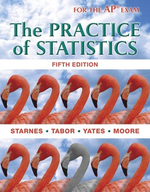Solution Found!
Solved: Benfords law Faked numbers in tax returns, invoices, or expense account claims
Chapter 11, Problem 11(choose chapter or problem)
Benfords law Faked numbers in tax returns, invoices, or expense account claims often display patterns that arent present in legitimate records. Some patterns are obvious and easily avoided by a clever crook. Others are more subtle. It is a striking fact that the first digits of numbers in legitimate records often follow a model known as Benfords law.3 Call the first digit of a randomly chosen record X for short. Benfords law gives this probability model for X (note that a first digit cant be 0): First digit: 1 2 3 4 5 6 7 8 9 Probability: 0.301 0.176 0.125 0.097 0.079 0.067 0.058 0.051 0.046 A forensic accountant who is familiar with Benfords law inspects a random sample of 250 invoices from a company that is accused of committing fraud. The table below displays the sample data. First digit: 1 2 3 4 5 6 7 8 9 Count: 61 50 43 34 25 16 7 8 6 (a) Are these data inconsistent with Benfords law? Carry out an appropriate test at the a = 0.05 level to support your answer. If you find a significant result, perform a follow-up analysis. (b) Describe a Type I error and a Type II error in this setting, and give a possible consequence of each. Which do you think is more serious?
Questions & Answers
QUESTION:
Benfords law Faked numbers in tax returns, invoices, or expense account claims often display patterns that arent present in legitimate records. Some patterns are obvious and easily avoided by a clever crook. Others are more subtle. It is a striking fact that the first digits of numbers in legitimate records often follow a model known as Benfords law.3 Call the first digit of a randomly chosen record X for short. Benfords law gives this probability model for X (note that a first digit cant be 0): First digit: 1 2 3 4 5 6 7 8 9 Probability: 0.301 0.176 0.125 0.097 0.079 0.067 0.058 0.051 0.046 A forensic accountant who is familiar with Benfords law inspects a random sample of 250 invoices from a company that is accused of committing fraud. The table below displays the sample data. First digit: 1 2 3 4 5 6 7 8 9 Count: 61 50 43 34 25 16 7 8 6 (a) Are these data inconsistent with Benfords law? Carry out an appropriate test at the a = 0.05 level to support your answer. If you find a significant result, perform a follow-up analysis. (b) Describe a Type I error and a Type II error in this setting, and give a possible consequence of each. Which do you think is more serious?
ANSWER:Step 1 of 4
Given data
Null hypothesis:
Alternative hypothesis
